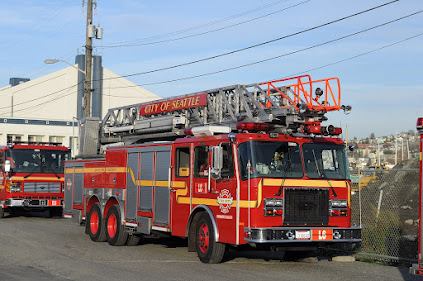 |
| Calling 9-1-1 for all situations is not ideal - photo Creative Commons |
GUEST BLOG: Beth Dufek is a writer and marketing strategist for clients improving the built environment. She runs her own consulting firm in the Pacific Northwest. Previously she worked with the LISC non-profit organization, facilitated SafeGrowth projects in Milwaukee, and later worked with neighborhood groups in Seattle, Washington. She was named one of the Milwaukee Business Journal’s Forty Under 40 for her commitment to civic engagement and her ability to build trust in communities. As a member of the SafeGrowth Network, she teaches SafeGrowth in cities across the U.S. This is Beth’s first blog on responding to people in crisis on the street.
I transitioned from architecture into community development in 2006. For a decade I worked side-by-side with residents, business owners, City officials, government agencies, and nonprofits – the proverbial “stakeholders”. Our goal was to reimagine neighborhoods, identify barriers, develop strategies, and create long-lasting partnerships that would deliver thriving communities throughout Milwaukee, Wisconsin, and Seattle, Washington. This is what draws me to SafeGrowth.
In 2011, especially for the Zilber Neighborhood Initiative in Milwaukee, we had a process, but we never called it the 5 Steps like we do in SafeGrowth. We identified achievable projects, brought residents together, and presented a compilation of projects tightly packaged into a plan to an audience we hoped would help us with funding or other resources. The final product was an illustrated asset map, a neighborhood plan format that I love to this day.
 |
| Photo from Lindsay Heights plan - Zilber Neighborhood Initiative |
Fast forward to the next decade. In 2020 I joined the SafeGrowth Network, and I started co-facilitating SafeGrowth Trainings with Greg Saville in 2021. It was a natural transition. All neighborhood plans I have ever worked on, regardless of the income status of the residents, start with a safety strategy. Among the top issues: who do we call when we need help? And with the state of mental health and drug addiction in the Pacific Northwest, this need feels greater than ever.
WHO DO WE CALL
Case in point: in 2019 I took walks along Seattle’s waterfront. One week, I saw a human completely engulfed in a purple sleeping bag (I assumed it was a human) in the same position for 3 days in a row. The human in the sleeping bag was situated among people who were enjoying the park during sunny days. But they were in exactly the same position for 3 days. My imagination convinced me the sleeping bag was fuller than it was (perhaps a bloated dead body?). This vision played a significant role in my next moves.
My concern was for the lack of human interaction with other humans experiencing drug addiction and mental health crises. A simple “Are you OK?”, rather than stepping over a human slumped on the sidewalk, took center stage. What if they are dead? Or need help? Who do I call? I tried the non-emergency police. No answer. Seriously.
Sigh.
I called 911. I pleaded with them not to make a big deal, couldn’t someone just come by? The dispatcher asked me if I could tap the purple sleeping bag to see if they were OK, or alive. I can’t remember. No! I’m not trained to do this! What if I scare them and they attack me? What if they ARE dead?
 |
| Seattle Fire Department - Photo courtesy of Joe Mabel |
Minutes later a Seattle Fire Department truck came barreling through Myrtle Edwards Park, drove right past me and then called me to direct them to my location.
“Over here! Here I am! The one who has now disrupted everyone’s enjoyment of one of the 56 sunny days in Seattle because I care about this human … and listen to too many true crime podcasts!”
I turned to the human near me and apologized and explained a fire truck was not the outcome I had imagined. I had a guy on a bike in mind who could assess the situation and call for additional help if needed. I walked with the paramedic over to Denise. I know her name is Denise because he said, “Oh that’s Denise. Denise, are you OK?” She was very much alive and none too happy that her afternoon sleep was disrupted!
That made two of us.
Since then, I’ve been thinking; why can’t all humans have a non-non-emergency number to call just to get a wellness check when they see someone in crisis?
 |
| TriMet Safety Response Team - photo courtesy of TriMet |
ARE YOU OK?
Through the SafeGrowth network, I found an entire agency that feels the same way. In 2021, the first SafeGrowth Training I co-facilitated was for TriMet, the three-county transit agency in the Portland, Oregon metro area. To date, we have trained 37 TriMet department directors and safety, maintenance, construction, and planning staff on how to use the SafeGrowth method to make staff and community-informed safety improvements along the transit system.
We just wrapped up Part 1 for our third cohort of TriMet employees and TriMet contractors. This cohort has five members from TriMet’s Safety Response Team. I get emotional just thinking about how impressed I am with what they have done and what they plan to do to help the thousands of humans who find shelter along the TriMet system through their Reimagining Public Safety initiative.
In the next two blogs, I will write about TriMet’s Safety Response Team and the changing roles of transit operators, librarians, and other agencies that find themselves in new roles helping humans.
But for now, I will be brave and ask, “Are you OK?”
Great article Beth, thanks for sharing your experiences and for starting this important conversation in more circles.
ReplyDelete